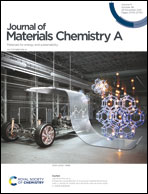Oxygen redox chemistry in P2-Na0.6Li0.11Fe0.27Mn0.62O2 cathode for high-energy Na-ion batteries†
Abstract
Owing to the abundance of raw material reserves and low cost, Na-ion batteries (NIBs) have successfully gained widespread attention from academic and industrial communities in the past few decades. However, the insufficient cathode energy density is still one of the critical bottlenecks restricting the development of NIBs. Following a strategy of introducing Li+ into the transition-metal (TM) layer to enhance the oxygen redox reaction, a novel layered cathode material P2-Na0.6Li0.11Fe0.27Mn0.62O2 (NLFMO) was designed and successfully synthesized. This NLFMO cathode not only delivers a large initial reversible capacity of 207.3 mA h g−1, but also shows a good cycling performance (104.2 mA h g−1 after 80 cycles) and rate capability (126.2 mA h g−1 at 1C). The ultrahigh capacity is contributed by both cationic (Fe3+/Fe4+ and Mn3+/Mn4+) and partially reversible anionic redox (O2−/On−) reactions, revealed by in situ X-ray absorption spectroscopy (XAS) and X-ray photoelectron spectroscopy (XPS) techniques. Moreover, no detrimental P2–O2 phase transition was observed in ex situ X-ray diffraction (XRD) patterns, confirming the high structural stability during Na+ deintercalation/intercalation processes. These results provide valuable information about the high-energy density layered cathode materials based on anionic redox reactions for NIBs.



 Please wait while we load your content...
Please wait while we load your content...